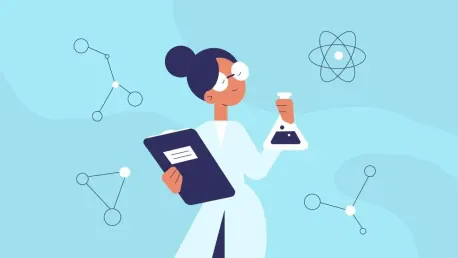Phenomena-based learning is transforming science education by captivating students’ curiosity about the world around them. This approach leverages students’ natural inquisitiveness through real-world phenomena, fostering a deeper, integrated understanding of scientific concepts. Unlike traditional memorization, phenomena-based learning emphasizes active, inquiry-driven exploration. Here’s how this innovative method is reshaping science education.
Engaging Student Curiosity
Practical and Observational Contexts
In phenomena-based learning, students engage directly with observable events, fostering a practical and captivating approach to education. For instance, the “Shadow Town” module designed for first-graders illustrates how this method works in a classroom setting. In this module, students explore the causes and behaviors of shadows by conducting outdoor experiments, creating a deeper interaction with the concept. The journey begins with a simple question, “What causes shadows?,” prompting students to test various ideas, such as whether they can outrun or trick their shadows into disappearing. These hands-on experiences, grounded in a real-world setting, provide students with a foundational understanding of light and darkness.
By actively engaging in experimentation and observation, students are not merely passive recipients of information but active participants in the learning process. This practical involvement allows them to understand the mechanics behind the phenomena they observe, such as the interplay between light sources and shadow formation. The tangible nature of these activities solidifies their grasp on scientific principles while simultaneously kindling a passion for inquiry and discovery. Thus, practical, observational contexts elevate traditional science teaching by making abstract concepts tangible and relatable, laying a robust foundation for future scientific exploration.
Harnessing Innate Curiosity
Curriculum modules centered around phenomena are exceptionally effective in harnessing students’ natural curiosity. By encouraging students to ask their own questions and investigate their surroundings, these modules pave the way for deeper engagement with science. For example, the module exploring why the town of Rjukan, Norway, experiences prolonged shadows provides a scenario ripe with complexity, yet approachable for young minds. This real-world problem not only captures the students’ interest but also motivates them to apply their growing knowledge to seek potential solutions, thereby deepening their understanding.
Such modules are designed to align with a child’s innate curiosity, making the learning process both enjoyable and meaningful. When students are driven by their interests and questions, the educational experience becomes intrinsically motivating. They transition from rote learning to a more dynamic, engaged form of inquiry. This approach not only makes science more accessible but also fosters critical thinking and problem-solving skills. As students navigate through their investigations, they learn to approach challenges methodically, testing hypotheses and drawing informed conclusions. By tapping into their natural curiosity, phenomena-based learning cultivates a lifelong love for science and the methodologies that underlie scientific discovery.
Alignment with 3D Science Standards
Three Core Dimensions of NGSS
Phenomena-based learning closely aligns with the Next Generation Science Standards (NGSS) and other three-dimensional science standards, which are structured around three core dimensions: Science and Engineering Practices (SEPs), Crosscutting Concepts (CCCs), and Disciplinary Core Ideas (DCIs). SEPs embody the methodologies and behaviors that scientists and engineers engage in, such as questioning, modeling, and data interpretation. These practices allow students to experience the processes of scientific inquiry actively, providing a hands-on, investigative approach to learning.
Crosscutting Concepts serve as thematic bridges across various scientific disciplines, emphasizing commonalities such as patterns, cause and effect, systems and system models, and energy and matter. These concepts help students to see the interconnectedness of scientific ideas, promoting a more integrated understanding of science. Finally, Disciplinary Core Ideas represent the fundamental scientific principles that students need to grasp, organized into domains like physical sciences, life sciences, Earth and space sciences, and engineering and technology applications. Together, these three dimensions promote a holistic approach to science education, steering away from isolated facts and encouraging a cohesive understanding of scientific concepts and processes.
Integrated Learning Approach
The integrated approach championed by phenomena-based learning promotes a cohesive understanding of scientific concepts rather than fragmented knowledge. In the “Shadow Town” example, students are engaged in SEPs by asking investigative questions, planning, and executing experiments. They utilize the CCC of patterns by meticulously observing shadow behaviors throughout the day and apply DCIs related to Earth’s movements to explain their observations. This integrated learning method not only helps students acquire scientific knowledge but also models the thinking processes of scientists, fostering critical thinking and problem-solving abilities.
This methodological shift provides students with a more authentic scientific experience, aligning classroom learning with real-world scientific practice. Instead of passively receiving pre-digested information, students are active participants in their education, engaging in the scientific process from hypothesis formation to data analysis. This hands-on approach encourages deep comprehension and retention, as students are better able to grasp and remember concepts they have actively explored and applied. By experiencing science in this holistic, integrated manner, students develop a richer and more enduring understanding, equipping them with the critical skills necessary for both academic and real-world success.
Design of Instructional Materials
Rich, Real-World Phenomena
Translating the principles of phenomena-based learning into effective instructional materials requires a focus on real-world phenomena that are genuinely observable, relevant, and complex enough to engage students, yet accessible for their level of understanding. High-quality multimedia resources are invaluable in this endeavor. Videos, interactive simulations, and other digital assets bring these phenomena to life, providing visual and dynamic experiences that traditional textbooks cannot match. By offering an immersive encounter with the phenomena, these resources bridge the gap between theoretical concepts and practical understanding, making learning both engaging and comprehensible.
For example, multimedia resources can simulate environments and scenarios that are otherwise inaccessible to students, such as deep-sea ecosystems or astronomical phenomena. These tools make it possible for students to observe and interact with scientific phenomena in ways that enhance their understanding and retention. Moreover, they cater to diverse learning styles, accommodating visual, auditory, and kinesthetic learners. This inclusivity ensures that all students have the opportunity to engage with the material in a manner that suits their unique learning preferences, leading to a more effective and equitable educational experience.
Engaging and Coherent Learning Materials
For phenomena-based learning to be truly effective, the curriculum must be designed to guide students through the inquiry process in a coherent and engaging manner. This includes providing clear structures for reflection and discussion, which are crucial for deep learning. Materials should be designed to facilitate these discussions, encouraging students to articulate their observations, pose questions, and construct explanations based on the evidence they gather. These practices help students internalize the scientific process and develop their ability to think critically and communicate effectively.
In addition, these instructional materials must be inclusive, offering scaffolding that supports diverse learning needs. This might include differentiated instruction strategies, additional resources for students who need extra support, and extension activities for those ready to delve deeper into the topic. By catering to the varied needs of all students, the curriculum ensures that every learner can participate meaningfully in scientific investigations. This inclusivity not only enhances the learning experience for individual students but also fosters a classroom environment where diverse perspectives and approaches to problem-solving are valued and encouraged.
Effective Assessment Strategies
Gauging Prior Knowledge and Ongoing Progress
In the framework of phenomena-based learning, assessment strategies must be designed to evaluate not only students’ acquisition of knowledge but also their understanding and application of the NGSS dimensions. Pre-exploration activities are a valuable tool for gauging prior knowledge, allowing teachers to identify what students already know and to tailor instruction accordingly. Formative assessments, conducted throughout the learning process, are essential for tracking students’ ongoing progress. These can take various forms, including quizzes, journal entries, and group discussions, providing continuous feedback that helps both students and teachers identify areas of strength and areas needing further development.
Summative assessments, which occur at the conclusion of a module, measure overall understanding and mastery of the concepts and practices explored. These assessments ensure that students have not only retained the information but also can apply it in various contexts, reflecting a deep and comprehensive understanding. By incorporating a variety of assessment methods, educators can obtain a more holistic view of student learning, ensuring that the evaluation process captures both the acquisition of knowledge and the development of critical thinking and inquiry skills.
Data-Reporting Tools
Integrative data-reporting tools play a crucial role in tracking student development over time within a phenomena-based learning framework. These tools provide valuable insights into how students are progressing in their understanding and application of scientific practices (SEPs), crosscutting concepts (CCCs), and disciplinary core ideas (DCIs). By aggregating and analyzing this data, educators can identify trends and patterns in student learning, allowing for more informed instructional decisions.
These tools also enable teachers to tailor their instruction to meet the specific needs of their students. For instance, if data reveals that a group of students is struggling with understanding a particular concept, the teacher can provide targeted interventions to address these gaps. Conversely, for students who demonstrate advanced understanding, teachers can offer enrichment activities to further challenge and engage them. By utilizing data-reporting tools effectively, educators can ensure that all students receive the support and resources they need to succeed in a phenomena-based learning environment.
Benefits Beyond the Classroom
Lifelong Curiosity and Critical Thinking
The impact of phenomena-based learning extends far beyond the walls of the classroom, equipping students with invaluable skills for lifelong learning. Engaging with real-world phenomena encourages students to not only absorb scientific concepts but also to internalize the processes and methodologies employed by scientists. This fosters a sense of wonder and inquiry that persists long after the formal education process has concluded. Students learn to approach problems methodically, test hypotheses, analyze data, and draw conclusions, mirroring the essential practices of scientific inquiry.
These skills are not confined to the realm of science but are transferable across various domains of life. By developing critical thinking and problem-solving abilities, students are better prepared to navigate the complexities of the modern world. They become adept at asking probing questions, evaluating evidence, and making informed decisions, whether in their personal lives or future professional endeavors. In this way, phenomena-based learning cultivates not only scientific literacy but also a broader intellectual agility that equips students for a lifetime of curiosity and exploration.
Preparation for Future Challenges
Phenomena-based learning is revolutionizing science education by tapping into students’ innate curiosity about their surroundings. This innovative approach uses real-world phenomena to spark students’ interest, promoting a richer, more holistic grasp of scientific principles. Unlike traditional methods that focus on rote memorization, phenomena-based learning prioritizes active, inquiry-driven exploration and critical thinking.
In this method, students encounter real-life situations that naturally integrate various scientific concepts. For example, studying a rainbow can lead to discussions about light refraction, weather conditions, and even the color spectrum. This multifaceted approach helps students see the interconnectedness of scientific ideas, making learning more meaningful and engaging.
Teachers act as guides, facilitating hands-on activities and encouraging students to ask questions, conduct experiments, and analyze data. This form of learning not only enhances understanding but also fosters a love for science by making it relevant and exciting. As students explore and experiment, they develop critical thinking skills and a deeper appreciation for the scientific process.









